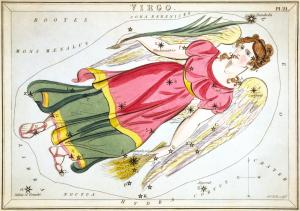Blog
Game of the Name
13 July 2015
 Sidney Hall, via Wikimedia Commons
Sidney Hall, via Wikimedia CommonsWhat’s in a name? Take, for example, the star GSC 0129-01873. It’s also known as HIP 27989, BD +07 1055, HD 39801, SAO 113271, and Alpha Orionis. Most commonly it’s known as Betelgeuse.
Now you might think: Betelgeuse? Seriously, why didn’t you say that in the first place? For a star like Betelgeuse, that’s a reasonable argument, since the star is one of the most well known first magnitude stars. But what about Zaniah? Without asking Google, could you find it in the sky? Probably not. Some well-versed astronomers might recognize it as Eta Virginis, which means it is the 7th brightest star in the constellation Virgo. This naming scheme comes from Johann Bayer’s Uranometria star catalog of the early 1600s, which named stars by the constellation in which they reside in order of brightness assigned by Greek letters. Thus Alpha Orionis is the brightest star in Orion.
In the 1800s, Friedrich Bessel began a project to catalog all stars brighter than ninth magnitude. It came to be known as the Bonner Durchmusterung (BD) catalog, which gave the positions and estimated magnitudes of more than 300,000 stars. In this scheme stars are defined by their declination and right ascension in the sky. Stars were clustered by their declination in degrees, then sequentially by right ascension. Thus Zaniah becomes BD +00 2926.
By the early 1900s photographic plate astronomy allowed for more precise measurements of position and magnitude as well as measurements of a stars spectra. The widow of astronomer Henry Draper began a fund to support the spectral classification of stars. This funded the work of Annie Jump Cannon and other women of the Harvard College Observatory to classify and catalog more than 400,000 stars. In this catalog stars were simply numbered consecutively in the order of their classification. Thus Zaniah is simply HD 107259. The Draper catalog remains of of the most commonly used star catalog.
HIP stands for the HIPPARCOS satellite, which measured the parallax of more than 100,000 stars. They are again simply listed sequentially, and Zaniah is HIP 60129. SAO is the Smithsonian Astrophysical Observatory, which groups stars within 10-degree bands of declination, which are then sorted by right ascension. Zaniah is therefore SAO 138721.
While Orion has a GSC designation, Zaniah does not. That’s because GSC is a Guide Star Catalog. It is used by the Hubble space telescope to locate guide stars within a field of view. By using guide stars, the Hubble telescope can ensure that it stays in alignment. Because of this, binary and multiple stars are excluded since they are not suitable as guide stars. Since Zaniah is a triple star it’s not part of the list. In the GSC the first number represents a Hubble sky region code, and the second number is sequential. The GSC contains nearly a billion stars down to magnitude 21. Only a small fraction of those stars have common names.
The universe is a very big place, and we can’t have a name for everything.